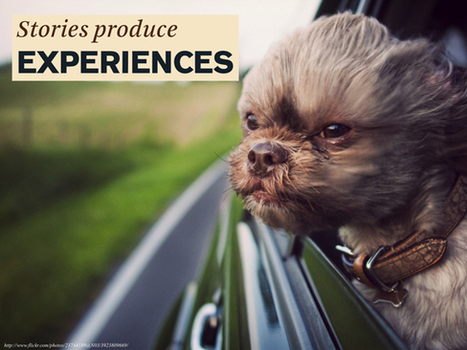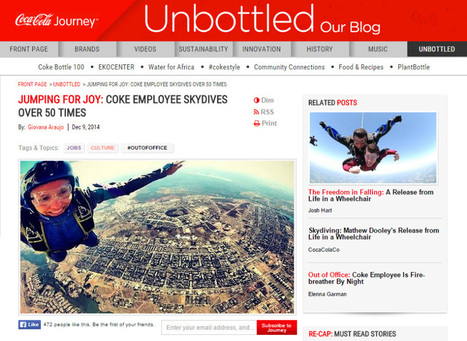 Your new post is loading...
 Your new post is loading...
Brands have turned to content to tell stories with content marketing. With access to broad distribution channels, it's easier than ever before to consume, create and distribute content. But where should a brand start?
Delving into content marketing and brand storytelling can be daunting, especially if you are just beginning. Here are four tips for brands becoming publishers to get started.
“Storytelling.” It’s the flavor of the day, whether you’re talking about content marketing, visual communications or public relations, and for good reason. Stories are how humans communicate – with each other individually, across populations and over centuries.
In fact, many organizations are pretty good at identifying and defining their key story lines. The key to success in brand storytelling is in the next step – the strategic deployment of the story. Telling the brand story effectively requires a plan.
And to be clear, we’re not talking about hanging a touchy-feely post up on the blog and then calling it a day. No. Brand storytelling, in this context, means developing a sustained plan to create and execute a strategic approach to telling the brand story, in a way that supports company’s objectives. Personally, I don’t give a hoot about impressions. Let’s gun for something a bit more meaningful....
...But while brand storytelling may be dominating the trade conference stages, it’s not enough on its own for brands aiming to add meaningful value to their customers over the long term.
Strategies for Retention: Own Every Consumer Touch Point
Most content marketers know this particular statistic: 70 percent of consumers prefer getting to know a company via content over ads. To deliver this type of lasting, comprehensive value to their audiences, brands must build their content strategy around three core areas of focus: Foundational content Engagement content Social content...
...Although companies understand the part about becoming a media company they missed something very important: media companies don’t create media about themselves. This is why companies have problems with the content they produce, people are immediately skeptical about any media that is about the company that produces it — no matter how high the quality.
Take a look at the Nielsen study released this week, commissioned by InPowered. It found that branded content ranked extremely low among consumers but content written by journalists — independent of any brand — ranked very highly....
Earlier this week, Coca-Cola declared the corporate website dead.
Take one quick look at their new corporate website and I think you will see an example of the future of quality content marketing. They are clearly displaying how the art of storytelling not only can influence our preference for a brand or product, but surely their intent is to also reach a search engine position of respect and power....
So what happens if you don’t wrap up your facts in emotion to form a story? Well, if your salespeople don’t introduce the main buying themes with a quick 2-minute story, won’t your salespeople sound like they are reading straight from a product manual? Without a story to give your product context, aren’t your customers left to try to figure out why it makes sense for them to buy, or even worse, why they should care?
And if your salespeople are selling how your product can improve results by 20%, don’t they end up sounding like every other software vendor? Won’t the prospect discount 90% of those claims?But what would happen if they instead shared a story about a similar customer. And this story highlighted in detail the limitations of their current system? Wouldn’t the prospect suddenly see how their system could potentially be improved? Would prospects then be more willing to hear about your solution, because your salesperson first sold the problem? Don’t you agree that you’ve got to open the gap before you can close it?
So ask yourself if your salespeople shared just one story per meeting, and did everything else the same, would customers relate more to what they’re selling?
I think advertisers are smart to want to have their ad copy look, read, and sound more like journalism. It’s a form of flattery for what we do, and although trust has waned in our profession recently—the public sees that our journalism is not as good as it used to be–it means that at least that the Mad Men of Madison Avenue think we’re more trustworthy than they are.
There’s an informative website, brandjournalists.com, that explains what these new kinds of ad producers do and why. It’s instructive.At base what they say they are doing is story telling. And, as they say, a good story is the essence of human communication. We journalists know that, or at least we should. If you can tell a good story about a company or organization, that’s likely to sell more product than the best old-hat sales pitch, the brand journalists reason.
They’re right. I agree with the ad folks that most companies have a good story to tell. I used to cover business and I never found a business I couldn’t find something interesting and newsworthy to write about.But let me show you how journalism is different than “brand journalism” or other kinds of sponsored content. This story you might even know....
...So the question is: Why is a story so important to your personal branding strategy? First of all, it sets your brand apart as unique. Every brand has its own story to tell, but yours is the only one of its kind. What drives you? Why did you enter the field that you find yourself in today? You’d be surprised at what details will intrigue the reader and give your audience an idea of what your brand is really about. Perhaps one of the most effective characteristics of a story is that it humanizes your brand. It’s easy to launch a brand, but the story behind it can leave your target audience wondering where it came from. What is your actual purpose? What drives your actions? Was it the right opportunity at the right moment? Now consider how your brand has affected others. How have you impacted the lives of those involved with your brand? Has it always gone smoothly? Are you new at this? What’s your experience prior to the creation of your brand? What is the story behind your personal brand? While the story for your brand might satisfy your present audience, the aspects of your personal brand story can turn you from just a brand into the personification they can truly relate to....
|
Authentic stories help powerful brands make deep connections with customers. But that high-level principle creates real-world challenges for content marketers. What is a powerful story and how do you tell it? I’d like to share four tips on how to tell stories that make connections and get results.
“Deconstructing the art and science of storytelling, This sentence, the one you're reading right now, is the most important one in this entire feature.”
There are two important parts of delivering a message: the delivery and the message. If one is a dud, it doesn’t matter how good the other one is.
You wouldn’t read a story if it was printed underneath a bus, and the most atrocious film in the world is still a car-crash if played on an IMAX cinema. The same applies to your brand storytelling, you can have the most heartwarming and engaging campaign in the world, but if it’s not delivered effectively your time and money has been wasted.
You wouldn’t want to spend months creating an incredible story only for nobody to hear it, would you? Every day there are brands who do this by not thinking carefully about how to present their message to their audience. An intelligent delivery strategy will make it easier for people to hear the story you want to tell, optimizing your chances of turning them into customers. Here’s how to ensure that the story your brand is telling doesn’t get missed...
Alan Berkson has a unique place in the world of thought leadership. He is the guy who has the science of the corporate narrative nailed. Just plain pinned...
Let's welcome Alan Berkson, from Freshdesk, who is not only a thought leader but someone who has carved a special place in the pantheon. Alan is an expert at defining a corporate narrative - an area of paramount importance in a business world defined by digital transformation. A corporate narrative? Are you surprised? The 21st century demands that companies present themselves in new ways. For example, old school product marketing, based on the exhibition of features and functions, no longer works or is even likeable in any way. It now demands something akin to "a day in the life." How are the products going to affect the outcomes I'm looking for as my day proceeds? In other words a narrative, a story.
But Alan is speaking on a bigger stage than just product marketing. He's looking at the strategic requirement that the companies who are trying to engage with customers have a the same time the customers have the opportunity to express themselves with strong collective power....
Welcome back to the countdown of 50 Brands With Amazing Brand Stories. I’ve shared some of my favourite stories so far, but now it gets down to the nitty-gritty as we delve into the top 20.Today we continue the countdown by looking at 20-11, but should you wish to see the previous editions, do so here: 30 – 21 l 40 – 31 l 50 – 41
Using storytelling to sell a product, brand or service isn’t in any way a new concept. The developing technology around us however, has given us new ways in which to engage and interact with our audience. Content marketing has become increasingly important as brands realize that in order to speak to their customers they need to invest in content that matters. The more brands have begun to focus on quality content, the more it becomes clear that storytelling is a key component to the content marketing process.
You wouldn’t (willingly) sit through a terrible film, or keep reading a book that you thought had a terrible plot, so why should people read your content if it doesn’t have a good story behind it?...
Not that long ago we started distinguishing between owned, earned and paid media but how real was that? Media evolutions that scare me.... If you’re looking for tips and tricks regarding the evolutions in brand journalism and the usage of content marketing (oops, I used the term) in branding and PR, don’t read this. If you want an opinion (mine, that is) on the dangers of some content and media evolutions, read on. I have a good friend who’s quite cynical, even more than I am. He sees marketing as lying and making people pay too much for products. I can’t even blame him. As a former journalist and publisher but at the same time a marketer, I’m in a constant state of duality regarding the role of both journalism/media on one hand and marketing on the other. And in this “digital and social age” it’s getting worse. If you know part of the role of a publisher (read on) you’ll understand that duality. Also look at the number of journalists becoming “content marketers”. Are there still journalists in fact? I never read a story about a “content marketer” becoming a journalist. Especially phenomena such as brand journalism (for later blog posts) and converged media confuse me in an ‘ethical’ way. Marketing is business. Brands are business. Media is business. Brand journalism is business. If media converge, do we still have credible media? Each time I preach people-centric and human marketing, I hope you keep that in mind. We are not doing business for a greater moral cause (although we can, more than ever)....
Customers own the story of the brand now. What brands say is far less important than what brands actually do to serve the well being of the faithful. Whereas before, the brand conversation was based on delivery and interruption, successful brand conversations are now participatory in ever more technology driven channels. Storytelling is at the very heart of how we humans share and connect what we value about our heritage, our communities and ourselves. Brand storytelling is about connecting the outer value the brand provides to the inner values of the customer. There must be a deep affinity between the two or the relationship is just a transaction. The foundation for this affinity is built on the shared stories between brands to consumers, customers to brands, and consumers to consumers. Like all relationships, there has to be chemistry. Brands have it or they don’t. How well these collective stories line up with the experience customers have is what creates “insistence without substitutes” in the minds of customers....
Via massimo facchinetti, Jesse Soininen
|
 Your new post is loading...
Your new post is loading...
 Your new post is loading...
Your new post is loading...






























Here are four simple tips for better brand and business storytelling.